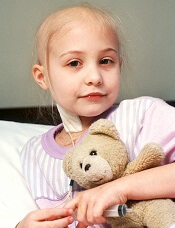
Credit: Bill Branson
Children recently diagnosed with standard-risk acute lymphoblastic leukemia (ALL) are likely to have few long-term complications into adulthood, investigators have reported in The Lancet Oncology.
The team said this is because current therapies are less harsh than their predecessors.
Newer protocols have eliminated radiation and restricted the use of chemotherapeutics that may cause subsequent malignancies and other chronic health conditions.
Previous research had only assessed the very long-term outcomes of children treated with older protocols, leaving physicians to piece together information from this outdated data and anecdotal evidence.
“This is one of the first studies to show that, in addition to their excellent probability of survival, long-term survivors of standard-risk childhood ALL are at low risk for complications of their therapy once they enter adulthood,” said study author Paul Nathan, MD, of The Hospital for Sick Children in Toronto, Canada.
He and his colleagues used longitudinal data from the Childhood Cancer Survivor Study, a North American study of 5-year survivors of childhood cancer diagnosed between 1970 and 1986.
The team analyzed 556 patients from this study who were older than 1 year of age and younger than 10 at the time of diagnosis and who had received treatment consistent with current therapies for standard-risk ALL.
Patients were followed from 5 years following diagnosis to a median of 18 years. The survivor group was compared with a group of their siblings who had not had cancer, as well as the general population.
Twenty-eight patients in the survivor group died. Sixteen of these deaths were from causes other than relapse.
Survivors were at a slightly increased risk of death due to non-relapse causes, when compared to controls. However, no individual cause was increased.
Six survivors developed another malignancy. The risk for most chronic health disorders did not differ between survivors and siblings. But survivors appeared to have a moderately increased risk for osteoporosis or osteopenia, short stature, and cataracts.
Survivors and their siblings had similar socioeconomic outcomes, including education, rates of marriage, independent living, and household income.
While these results suggest the prognosis is favorable, Dr Nathan noted that ALL survivors should receive ongoing care from a knowledgeable primary-care practitioner.
“Among kids with standard-risk ALL, we expect most to survive,” Dr Nathan said. “Now we can say with more certainty that they will probably do well in the long-term as well. This information will be very useful for oncologists counselling newly diagnosed patients and their families and will be quite reassuring to parents.”

